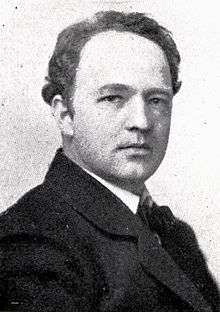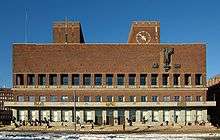Magnus Poulsson
Magnus Poulsson (14 July 1881 – 18 March 1958) was a Norwegian architect.


Biography
Poulsson was born in Drammen, Buskerud county, Norway. His parents were Søren Anton Poulsson (1847–1934) and Ina Bolette Jørgensen (1851–1922). He studied at Den kongelige Tegne- og Kunstskole i Christiania, now the Norwegian National Academy of Craft and Art Industry in Oslo from 1900–03, at the Royal Institute of Technology in Stockholm from 1903–1905 and apprenticed from 1905–09. Poulsson established his own practice in Oslo during 1909 and worked closely with Arnstein Arneberg.
Magnus Poulsson is most famous for designing the Oslo City Hall, together with Arnstein Arneberg.[1] He is also known for his work on Bærum City Hall (Bærum Rådhus) in Sandvika (1925 and 1958), KNA Hotel in Oslo (1931), Eystein church in Hjerkin and Haslum Chapel in Bærum. Poulsson's work also included private residences, office buildings, churches and interiors. Magnus Poulsson was particularly known for recreating the tradition of Norwegian folk wooden architecture.[2]
Poulsson was chairman of the Ancient Monuments Society 1917–1930 and chairman of the supervisory committee for the Nidaros Cathedral reconstruction from 1931–58. He was an honorary member of the Danish AKAD and a member of the Swedish Royal Academies for Fria Art Erna.[3]
Awards
- Houen Foundation Award -Det Forenede Dampskibs-Selskab, Karl Johans gate 1, Oslo (1925)
- Houen Foundation Award - Bærum Rådhus, Sandvika (1930)[4]
- Commander of the Royal Norwegian Order of St. Olav (1950)
- Medal of St. Hallvard (1956)
References
- "The Nobel Peace Prize Ceremony in the Oslo City Hall". Norwegian Ministry of Foreign Affairs. Retrieved 15 March 2010.
- "Bærum municipal website". Archived from the original on 9 December 2012. Retrieved 15 March 2010.CS1 maint: BOT: original-url status unknown (link)
- Magnus Poulsson / utdypning (Store norske leksikon)
- Magnus Poulsson (Houens fonds diplom) Archived 2011-07-19 at the Wayback Machine
| Wikimedia Commons has media related to Magnus Poulsson. |